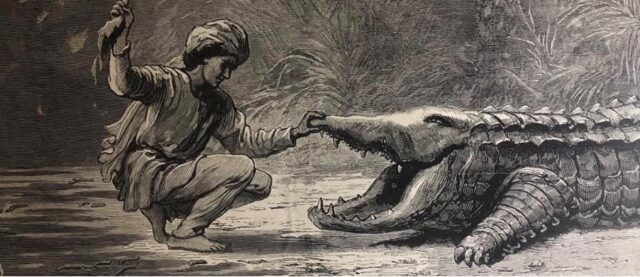My trip to Karachi was unfortunately delayed because of what can only be described as a series of unfortunate events. While I was originally scheduled to land in Islamabad, Pakistan, on the 19th of June, I ended up arriving on the 8th of July due to successive flight cancellations. Thankfully though, I used the additional time to ruminate over how this research might be incorporated into my Gallatin senior project while also compiling a list of supplemental secondary source materials.
Most notably, while in New York, I connected with a Ph.D. candidate whose thesis research is on the Sheedi community in Karachi. She helped me better articulate my central research questions and provided me with additional guidance on how to conduct ethnographic/oral history interviews.

British visitors watch on as patrons feed the crocodiles, 1870
Barring the fact that this month was mostly spent reading and rereading additional secondary materials, I fortuitously managed to visit Karachi on a layover between New York and Islamabad. In that visit, I conversed with individuals from the two provinces where the Sheedis mainly resided and noted the emergence of an interesting phenomenon. While the Sheedis in Sindh and the Sheedis in Balochistan are two distinct groups that belong to two distinct ethnicities, in my conversations with Sindhis and Baloch people, I started noticing, ever-so-subtly, that neither group believed that Sheedis were a member of their ethnicity. That, oddly enough, their racial identities as Afro-Pakistanis, stripped them of their ethnic identities – despite living in the province and speaking the language for centuries.
I’ve realized that there is a lot of knowledge about the community, the shrine, and the saint that I will realistically not be able to acquire over the summer. I do hope that my interest in the community and this shrine does not wane upon the conclusion of my paper.

A sketch made by a British Orientalist depicting the Manghopir lake. (19th century)
Lastly, I am attaching archival sketches of the crocodiles and the shrine through time. What’s most interesting to note about the last sketch is the fact that a Sheedi patron can be seen standing next to a British visitor/colonial official. It is images like this that I hope to uncover further at the Sindh archives. My trip to Karachi is scheduled for the last week of July. For now, what I am looking most forward to are my interviews with Sheedi elders.

